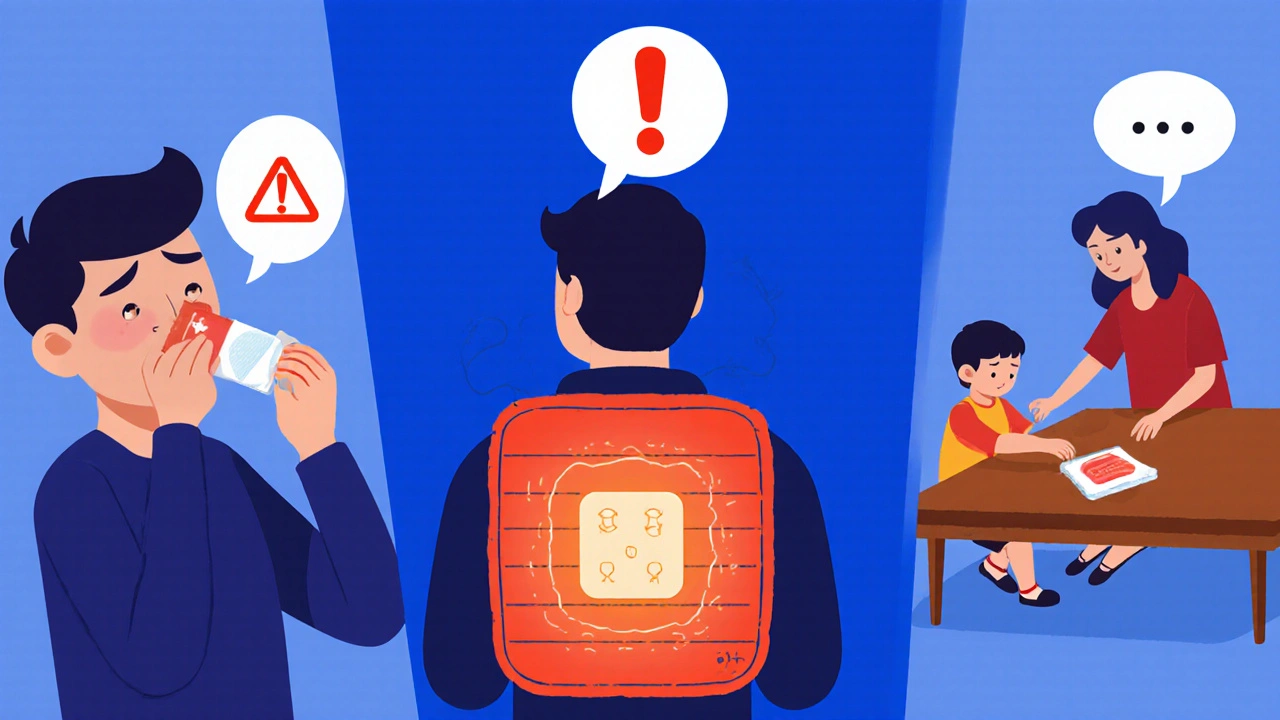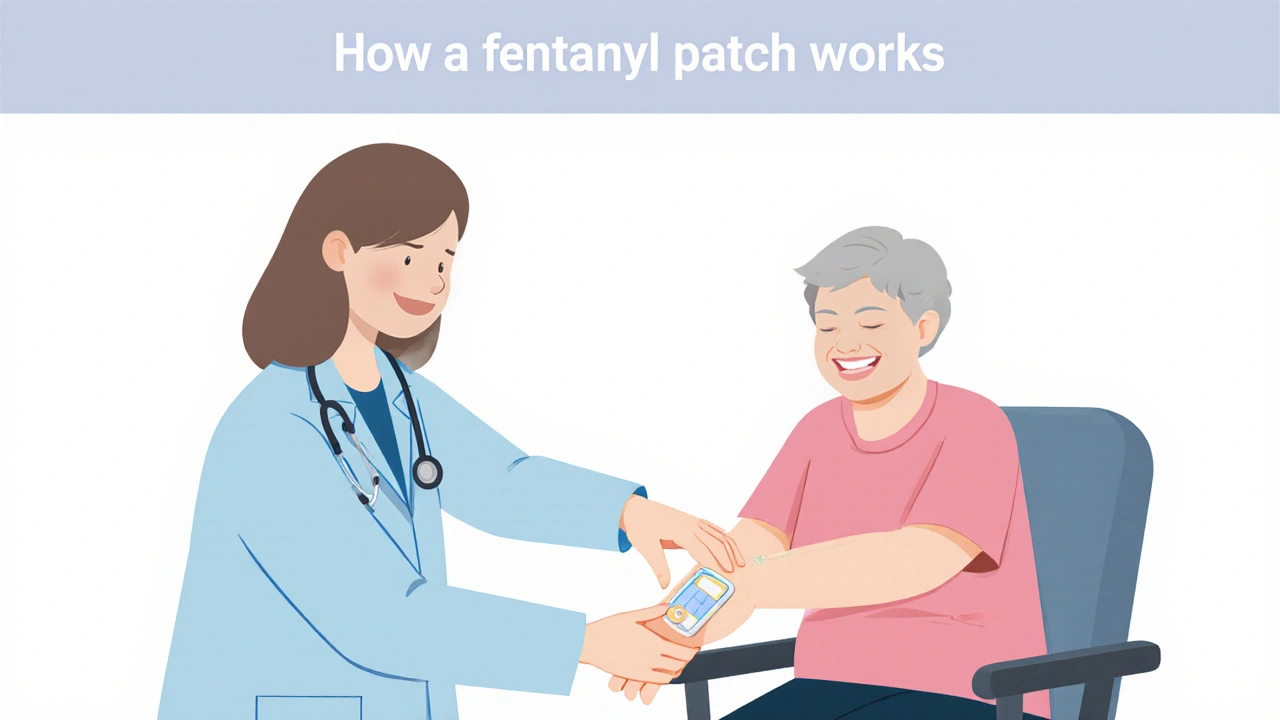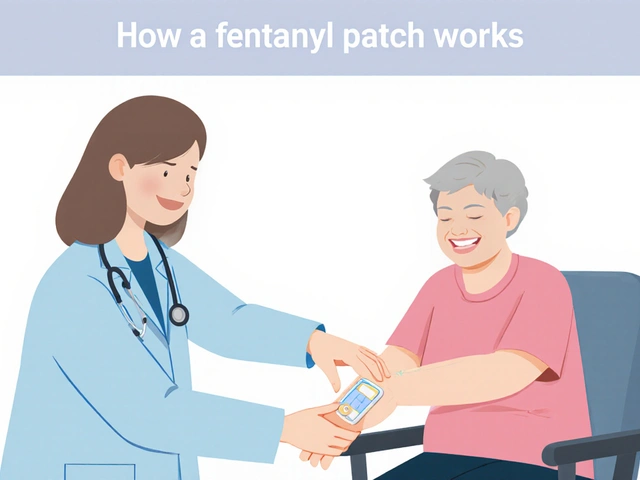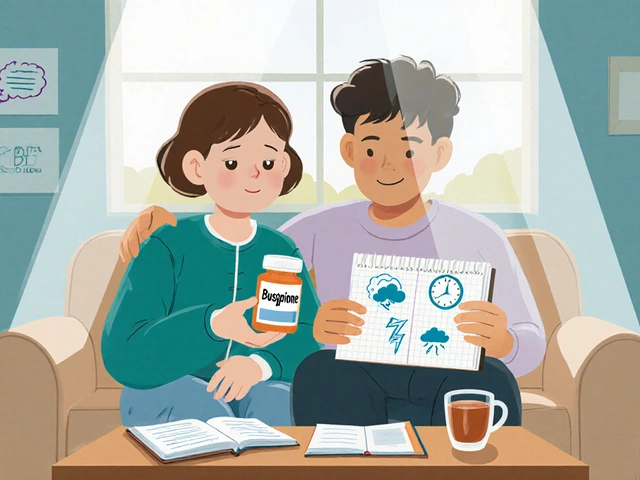Fentanyl Patch Heat Exposure Calculator
Calculate Your Risk
Fentanyl patches absorb faster when skin temperature rises. This calculator shows how much your fentanyl absorption may increase based on your skin temperature.
Enter your information above to see your risk level.
Risk Assessment
What to Do Next:
- Remove patch immediately
- Monitor for overdose symptoms
- Contact your healthcare provider
When a doctor prescribes a fentanyl patch side effects guide, the goal is to keep the relief steady while avoiding a dangerous surprise. Fentanyl transdermal patches are among the most potent opioid delivery systems on the market, delivering a constant drip of medication for up to three days. That steady flow is a blessing for chronic pain patients, but it can also turn into a nightmare if the patch isn’t used exactly as instructed. Below you’ll find everything you need to know about the biggest hazards - overdose and withdrawal - plus practical steps to stay safe.
What is a fentanyl transdermal patch?
Fentanyl transdermal patch is a medicated adhesive designed to release fentanyl citrate through the skin at a controlled rate for 72 hours. The patch contains a reservoir of the drug and a rate‑controlling membrane that lets the opioid diffuse into the dermal layers. Doses range from 12 µg/hour to 100 µg/hour, allowing clinicians to match the strength to a patient’s opioid tolerance.
Key technical points:
- Steady‑state plasma levels are usually reached within 12-24 hours of the first application.
- Absorption spikes when skin temperature rises - fever, heating pads, hot tubs, or even a sunny car seat can boost fentanyl levels by up to 25%.
- The patch must stay on intact skin; bruised, irritated, or oily areas reduce efficacy and increase the risk of uneven dosing.
Why the risk profile looks different from oral opioids
Oral opioids create peaks (when the drug hits the bloodstream) and troughs (as the dose wears off). Those fluctuations can cause breakthrough pain, but they also give the body a chance to metabolize excess drug. The patch, on the other hand, keeps blood levels flat - which means fewer pain spikes, but also less room for error. A small mistake, like applying a second patch or exposing the patch to heat, can push the dose into a toxic range in minutes.
Common side effects you’ll see early on
Most patients experience mild-to-moderate effects that fade as the body adjusts. Typical complaints include:
- Dry mouth
- Constipation
- Drowsiness or mild sedation
- Nausea
- Skin irritation at the application site
These are usually managed with supportive care - plenty of fluids, fiber supplements, and rotating the patch site every 48‑72 hours.
When side effects become an overdose
Overdose is the most serious hazard, and it can happen in three main ways:
- Accidental double‑dose: Adding a new patch before the old one is fully removed.
- Heat‑induced acceleration: Using a heating pad, taking a hot bath, or having a fever.
- Accidental exposure: Children, pets, or caregivers touching a used or unopened patch.
Because fentanyl is 50-100 times more potent than morphine, even a fraction of a patch can be lethal to opioid‑naïve individuals.

Recognizing an overdose - what to look for
| Sign | Typical Side Effect | Overdose Indicator |
|---|---|---|
| Breathing rate | Normal‑slow (12‑20/min) | Shallow or stopped breathing |
| Pupil size | Slightly constricted | Pinpoint (≤2 mm) or wildly dilated |
| Skin color | Normal pink | Pale, blue, or clammy |
| Consciousness | Mild drowsiness | Extreme sleepiness, unresponsiveness |
| Heart rate | Regular 60‑100 bpm | Very slow or irregular |
If any of these appear, call 911 immediately and remove the patch. Have a prescribed naloxone kit ready - it can reverse the respiratory depression within minutes.
Withdrawal - the other side of the coin
Stopping fentanyl abruptly is just as risky as taking too much. The FDA’s 2019 safety announcement warned that sudden discontinuation can trigger a severe opioid‑withdrawal syndrome, which, while rarely fatal, can be extremely uncomfortable and may lead to relapse.
Typical withdrawal timeline (based on EMA 2022 data):
- Onset: 8-24 hours after the last patch removal
- Peak intensity: 36-72 hours
- Duration: 7-10 days, sometimes extending to several weeks
Common symptoms include:
- Restlessness, anxiety, irritability
- Yawning, lacrimation, rhinorrhea
- Muscle aches, chills, sweating
- Rapid heartbeat, elevated blood pressure
- Nausea, vomiting, diarrhea
In a minority of cases, patients experience suicidal thoughts, especially if withdrawal pain is unmanaged.
How to taper safely - a step‑by‑step guide
Physicians follow a gradual reduction plan to keep the body from swinging into withdrawal. The Mayo Clinic recommends cutting the dose by no more than 10‑25 % every 1‑3 weeks, depending on the starting strength.
- Consult your prescriber before making any change.
- Document the current patch strength and frequency.
- Reduce the dose: e.g., switch from a 75 µg/hr patch to a 50 µg/hr patch for two weeks.
- Monitor withdrawal signs daily; keep a symptom log.
- Adjust the taper speed if symptoms become severe - slower is safer.
- Consider adjunctive medications (clonidine, anti‑nausea drugs) to ease symptoms.
- Keep a naloxone kit on hand until the taper is complete.
High‑dose patients may need a multi‑month taper, sometimes extending beyond six months, to avoid “rebound” pain spikes.
Preventing accidental exposure
Because a single patch can contain up to 100 mg of fentanyl - enough to kill several adults - safety measures are non‑negotiable.
- Store patches in a locked container, out of reach of children and pets.
- Never reuse a patch or share it with anyone.
- When disposing, fold the sticky sides together, seal in a puncture‑proof bag, and place in household trash. Some pharmacies offer take‑back programs.
- Educate all household members about the danger of “finding” a patch.
- Avoid heat sources: no heating pads, hot tubs, saunas, or prolonged sun exposure on the application site.
Regulatory safeguards - what agencies are doing
The FDA implemented a Risk Evaluation and Mitigation Strategy (REMS) for all extended‑release opioids in 2012. The program forces prescribers to complete training and requires patient counseling about overdose, proper disposal, and tapering.
In Europe, the European Medicines Agency (EMA) released updated scientific conclusions in 2022, reaffirming that the benefits outweigh risks when the patch is used per label, but they called for stronger patient‑education materials.
Both agencies now require that any new fentanyl prescription be accompanied by a discussion of naloxone co‑prescribing, reflecting the 2023 FDA rule that aims to reduce fatal overdoses.
Quick checklist for safe fentanyl patch use
- Apply to clean, dry, intact skin - rotate sites every 72 hours.
- Never expose the patch to external heat.
- Remove the patch exactly 72 hours after application; fold sticky sides together.
- Keep a naloxone kit nearby and know how to use it.
- Store and dispose of patches securely.
- Follow a physician‑supervised taper plan when stopping.
- Report any side effects or suspicious symptoms to your health‑care team immediately.
Frequently Asked Questions
Can I swim while wearing a fentanyl patch?
Short swims (under 30 minutes) are usually safe, but hot tubs, sauna‑type pools, or prolonged exposure to warm water can raise skin temperature enough to increase fentanyl absorption. If you plan a long swim, remove the patch first.
What should I do if I miss a dose?
Do NOT add an extra patch. Contact your prescriber; they may advise applying a new patch at the next scheduled change or simply continue with the current one and monitor for increased pain.
Is it safe to use other opioids while on a fentanyl patch?
Combining opioids heightens the risk of respiratory depression. Only a doctor‑approved rescue medication (like short‑acting oxycodone) should be used, and it must be at a reduced dose.
How long does withdrawal typically last?
Most people feel the worst symptoms between 36 and 72 hours after the last patch. Symptoms usually subside within a week, but some-like insomnia or anxiety-can linger for several weeks.
Can I keep a used patch for future use?
No. Once a patch has delivered medication, its remaining fentanyl remains potent and dangerous. Fold it, seal it, and dispose of it promptly.








Lionel du Plessis October 25, 2025
Patch kinetics and thermodynamics interplay critically, especially with ambient heat sources.
Andrae Powel November 1, 2025
One of the most important steps is to schedule a baseline assessment before the first patch is placed.
Your clinician should document current pain scores, opioid tolerance, and any respiratory conditions.
Once the appropriate dose is selected, apply the patch to clean, dry, intact skin and rotate the site every 72 hours.
Keep a daily log of the patch change time, location on the body, and any side effects you notice.
If you experience persistent dry mouth, increase fluid intake and consider saliva substitutes.
Constipation is common; a fiber supplement and gentle laxative can keep things moving.
Should you develop a rash or irritation at the site, remove the patch and report it immediately so an alternative location can be chosen.
Be aware that external heat sources such as heating pads, hot tubs, or even a sunny car seat can boost absorption by up to 25 percent, so avoid them whenever possible.
In case of a missed dose, do not add an extra patch; contact your prescriber for guidance.
Keep a naloxone rescue kit within reach and make sure household members know how to use it.
When it’s time to taper, aim for a reduction of no more than 10‑25 percent every one to three weeks, adjusting based on how you feel.
Adjunct medications like clonidine or anti‑nausea agents can smooth the withdrawal curve.
Document any withdrawal symptoms such as yawning, chills, or rapid heartbeat, and share them with your doctor promptly.
Remember that sudden discontinuation can trigger severe symptoms, so a gradual taper is essential for safety.
Safe disposal is critical: fold the used patch sticky sides together, place it in a puncture‑proof bag, and throw it in regular trash or return it to a pharmacy take‑back program.
By staying informed and following these practical steps, you can minimize both overdose and withdrawal risks while maintaining effective pain control.
Leanne Henderson November 8, 2025
Wow, this is such a solid breakdown, I love how you listed the daily log idea, it really helps keep track, and the reminder about heat sources-so crucial! Also, the tip about keeping naloxone handy, that’s a lifesaver, literally. And the tapering schedule you suggested, cutting 10‑25 % every few weeks, sounds doable, especially with the adjunct meds you mentioned, like clonidine, which can calm those nasty withdrawal spikes. Thanks for being so clear, it makes the whole process feel less scary, more manageable. Keep the info coming!
Megan Dicochea November 15, 2025
Good point about heat. The temperature factor can be easy to overlook but it matters a lot. Always check the patch area before a sauna.
Edward Brown November 22, 2025
They want us to think the patches are safe but the pharma giants push them to lock us into dependence the moment we step into a clinic. The REMS program is just a PR move while the real profit comes from the next prescription.
Melody Barton November 29, 2025
Listen, the data is clear-improper use leads to overdose. Follow the guidelines, keep the patch away from heat, and get help if you feel unsafe.
Pamela Clark December 6, 2025
Oh great, another endless checklist on how to not die from a patch. As if we needed a PhD to read the warning label.